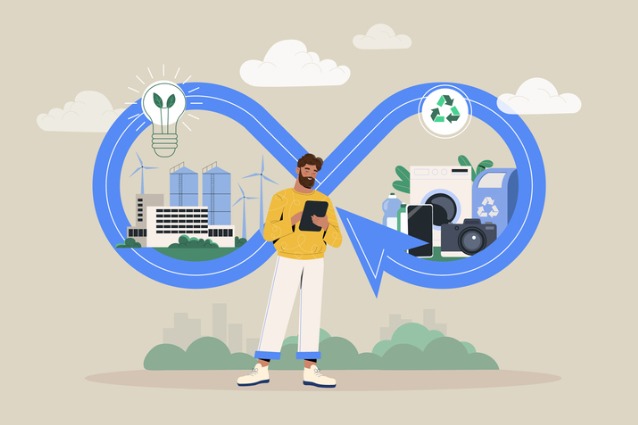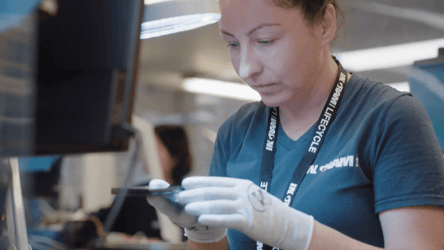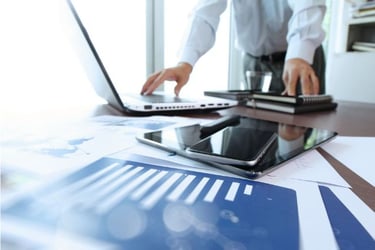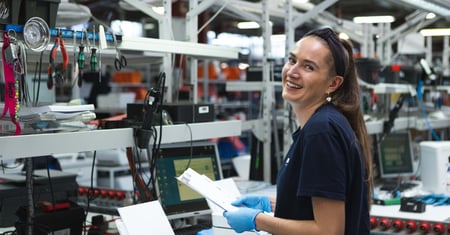Looking to learn more about how the shift to a circular economy is impacting how technology is used and owned? Keeping on top of the latest trends means your business can continue to innovate. Fail to do so and you’ll fall behind the competition!
Ingram Micro Lifecycle works with millions of devices every day to extend the lifecycle and keep them in circulation for longer. We’ve been supporting our customers for over a decade to enable a circular economy.
Below, we talk through three different impacts the technology circular economy is having on how we own devices.
A shifting mindset
We’ve spoken before about how the linear economy is becoming more recognized for the volume of waste it generates. Awareness of the circular economy approach is increasing, leading to the search for sustainable changes. E-waste is a huge by-product of the linear economy.
An average EU household owns 74 EEE (Electrical and Electronic Equipment). The WEEE Forum believes that 7 million metric tonnes of working electronics are hoarded, but not used. 3 million metric tonnes of broken electronics are kept.
All these goods could potentially become e-waste if not suitably disposed of.
At the end of 2022, there was an estimated 347.18 million metric tonnes of unrecycled e-waste. If left to break down and decay in landfill, harmful toxins can be released into the environment.
One way to reduce the volume generated is to increase the lifecycle of technology already in circulation. This reduces the need to manufacture more.
So how can we make more use of the technology already in existence?
4 Key Shifts in Sustainable Device Ownership
1. Leasing
Consider the amount of technology you own and use, either at home or at work. Do you need to own it? What if you could borrow the device for however long you wanted it?
Known as device as a service, the equipment manufacturer or retailer retains ownership of the product and instead charges a monthly fee for usage.
The leasing and asset financing model supports a circular economy because you only pay for a product when you want or need it. Returning the product to be reused by someone else means it’s not going to waste. The product could get repaired and refurbished to a usable condition and given a new lease of life with the next user.
The product you receive may not be brand new but you’ll have confidence in the processes that have got it to you, keeping it in as near new condition as possible.
Once your contract has ended, you can decide to renew or upgrade to a different device. This is great if you like having newer models and the latest technology. Also great if you’re happy with the device’s performance. The choice is yours.
If you don’t renew with that particular product, it will be repaired and refurbished to be contracted to someone else. The cycle repeats until the device is beyond economical repair, when it’ll be sustainably recycled or harvested for parts to help extend the lifecycle of similar products.
Learn more: Device as a Service vs Leasing: Which is Best for Your Business?
2. Asset management
How are you reading this article? On a smartphone or a desktop monitor?
When you no longer want those electronics, what will happen to them? They’re likely company assets - will they pass on to another user, sit in storage somewhere, or become e-waste?
If you had an asset management partner or the devices were leased, there’d be contracted support and repairs to ensure the life of the device is as long as it could be. This would guarantee an extended life for the device, keeping it ship-shape for as long as possible while it’s economically viable to do so.
The refresh point for your IT assets is postponed as the repairs ensure the devices are in long-term good working condition for longer. This minimizes the volume being made redundant and potentially going to landfill.
PS – it’s also better for your data security as there’s less risk of the devices sitting in storage with your data on it waiting to be compromised.
Blancco has found that more than a third of businesses in a study were taking “considerable risks” with data on end-of-life devices through insufficient sanitization, poorly audited chains of custody, and insecure storage. 80% of businesses’ had out-of-use equipment in storage, and the majority were conducting data erasure over a month after the device was decommissioned, enabling a window of opportunity for hackers.
Don’t just put your devices into storage when you have no need for them - get them securely wiped first by either an ITAD or asset management partner. The onus will be on them to compliantly decommission your devices or get them ready for reuse.
3. Buyback
When your fleet of devices is due a refresh, and you’re set on getting a brand new fleet, you can take advantage of a manufacturer or retailer buyback scheme.
These will buy obsolete devices from you in bulk. It’s like consumer trade-in schemes that are growing in popularity but on a larger scale.
Your unwanted devices will be data wiped, repaired and refurbished, and put onto the secondary market. Although you’ll be buying new, your decision to opt for buyback means that someone else has the ability to buy second-life devices, reducing their need to buy new.
4. Refurbishment
What does a new device give you that a refurbished one doesn’t? Do you need a brand-new device, or could you use a refurbished one?
A few years ago, there would be differences in quality and performance between the two. This is no longer the case. The reputation of refurbished devices has improved significantly.
The processes behind refurbished technology have innovated, meaning goods are of a much higher standard. Confidence in the quality has grown, which means these devices are more in demand.
Taking a refurbished device reduces the pressure of needing to manufacture new devices. The demand shifts from new to refurbished.
Ready to enable a circular economy?
Adopting any of the approaches above supports the move to a circular economy from the linear one.
Leasing your devices instead of owning them often entails extra support for you. You also know you’ve got the option to use the device for longer or upgrade when the contract is due to end.
The quality of used and refurbished devices is much higher due to todays standards and processes, so whether you lease or buy, it’ll be similar to a new device.
Whatever devices you own, you can support the circular economy by engaging in a buyback scheme so these securely extend the lifecycle of your devices for use on the secondary market.
If you’re looking for a partner to support these changes, we’re trusted by customers around the globe for lifecycle extension services, including asset management and aftermarket sales.
Reach out to our team today to discuss how we can help you.














